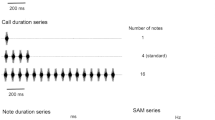Abstract
-
1.
Responses of 73 fibers to dorso-ventral vibration were recorded in the saccular and utricular branchlets of Rana pipiens pipiens using a ventral approach. The saccular branchlet contained nearly exclusively vibration-sensitive fibers (33 out of 36) with best frequencies (BFs) between 10 and 70 Hz, whereas none of the 37 fibers encountered in the utricular branchlet responded to dorso-ventral vibrations.
-
2.
Using a dorsal approach we recorded from the VIIIth nerve near its entry in the brainstem and analyzed responses to both sound and vibration stimuli for 65 fibers in R. pipiens pipiens and 25 fibers in Leptodactylus albilabris. The fibers were classified as amphibian papilla (AP), basilar papilla (BP), saccular or vestibular fibers based on their location in the nerve. Only AP and saccular fibers responded to vibrations. The AP-fibers responded to vibrations from 0.01 cm/s2 and to sound from 40 dB SPL by increasing their spike rate. Best frequencies (BFs) ranged from 60 to 900 Hz, and only fibers with BFs below 500 Hz responded to vibrations. The fibers had identical BF's for sound and vibration. The saccular fibers had BFs ranging from 10 to 80 Hz with 22 fibers having BFs at 40–50 Hz. The fibers responded to sound from 70 dB SPL and'to vibrations from 0.01 cm/s2.
-
3.
No differences in sensitivity, tuning or phase-locking were found between the two species, except that most BP-fibers in R. pipiens pipiens had BFs from 1.2 to 1.4 kHz, whereas those in L. albilabris had BFs from 2.0 to 2.2 kHz (matching the energy peak of L. albilabris' mating call).
-
4.
The finding that the low-frequency amphibian papilla fibers are extremely sensitive to vibrations raises questions regarding their function in the behaving animal. They may be substrate vibration receptors, respond to sound-induced vibrations or bone-conducted sound.
Similar content being viewed by others
Abbreviations
- SPL:
-
sound pressure level
- BF:
-
best frequency
- AP:
-
amphibian papilla
- BP:
-
basilar papilla
References
Christensen-Dalsgaard J, Jørgensen MB (1988) The response characteristics of vibration-sensitive saccular fibers in the grassfrog, Rana temporaria J Comp Physiol A 162:633–638
Christensen-Dalsgaard J, Jørgensen MB (1989) Response characteristics of vibration-sensitive neurons in the midbrain of the grassfrog, Rana temporaria. J Comp Physiol A 164:495–499
Ehret G, Tautz J, Schmitz B, Narins PM (1990) Hearing through the lungs: Lung-eardrum transmission of sound in the frog Eleutherodactylus coqui. Naturwissenschaften 77:192–194
Feng AS, Narins PM, Capranica RR (1975) Three populations of primary auditory fibers in the bullfrog (Rana catesbeiana): Their peripheral origins and frequency sensitivities. J Comp Physiol 100:221–229
Hartline PH (1971) Physiological basis for detection of sound and vibration in snakes. J Exp Biol 54:349–371
Jørgensen MB (1991) Comparative studies of the biophysics of directional hearing in anurans. J Comp Physiol A 169:591–598
Jørgensen MB, Christensen-Dalsgaard J (1989) Peripheral origins and functional characteristics of vibration-sensitive VIIIth nerve fibers in the grassfrog. In: Menzel R (ed) Proceedings of the second international congress of neuroethology. Georg Thieme Stuttgart, p. 90
Jørgensen MB, Christensen-Dalsgaard J (1991) Peripheral origins and functional characteristics of vibration-sensitive VIIIth nerve fibers in the frog Rana temporararia. J Comp Physiol A 169:341–347
Jørgensen MB, Schmitz B, Christensen-Dalsgaard J (1991) Biophysics of direclional hearing in the frog Eleutherodactylus coqui. J Comp Physiol A 168:223–232
Koyama H, Lewis ER, Leverenz EL, Baird R (1982) Acute seismic sensitivity in the bullfrog ear. Brain Res 250:168–172
Lewis ER, Lombard RE (1988) The amphibian inner ear. In: Frilzsch B, Ryan MJ, Wilczynski W, Hetherington TE, Walkowiak W (eds) The evolulion of the amphibian audilory system. John Wiley and Sons, New York Chichester Brisbane Toronlo Singapore, pp 93–123
Lewis ER, Narins PM (1985) Do frogs communicate with seismic signals? Science 215:187–189
Lombard RE, Slraughan IR (1974) Funclional aspecls of anuran middle ear slruclures. J Exp Biol 61:71–93
Moffat AJM, Capranica RR (1976) Audilory sensilivity of the saccule in the American toad (Bufo americanus). J Comp Physiol 105:1–8
Narins PM (1990) Seismic communication in anuran amphibians. BioScience 40:268–274
Narins PM, Hillery CM (1983) Frequency coding in the inner ear of anuran amphibians. In: Klinke R, Hartmann R (eds) Hearing — Physiological bases and psychophysics. Springer, Berlin, pp 70–76
Narins PM, Lewis ER (1984) The vertebrate ear as an exquisite seismic sensor. J Acoust Soc Am 76:1384–1387
Narins PM, Ehret G, Tautz J (1988) Accessory pathway for sound transfer in a neotropical frog. Proc Natl Acad Sci USA 85:1508–1512
Narins PM, Reichmann OJ, Jarvis JUM, Lewis ER (1992) Seismic signal transmission between burrows of the Cape mole-rat, Georychus capensis. J Comp Physiol A 170:13–21
Rado R, Levi N, Hauser H, Witcher J, Adler N, Intrator N, Wollberg Z, Terkel J (1987) Seismic signalling as a means of communication in a subterranean mammal. Anim Behav 35:1249–1251
Rado R, Himelfarb M, Arensburg B, Terkel J, Wollberg Z (1989) Are seismic communication signals transmitted by bone conduction in the blind mole rat? Hearing Res 41:23–30
Schmitz B, White T, Narins PM (1992) Directionality of phase locking in auditory nerve fibers of the leopard frog Rana pipiens pipiem. J Comp Physiol A 170:589–604
Vlaming MSMG, Aertsen AMHJ, Epping WJM (1984) Directional hearing in the grass frog (Rana temporaria L.): I. Mechanical vibrations of tympanic membrane. Hearing Res 14:191–201
Wilczynski W, Resler C, Capranica RR (1987) Tympanic and extratympanic sound transmission in the leopard frog. J Comp Physiol A 161:659–669
Yu X, Lewis ER, Feld D (1991) Seismic and auditory tuning curves from bullfrog saccular and amphibian papular axons. J Comp Physiol A 169:241–248
Author information
Authors and Affiliations
Rights and permissions
About this article
Cite this article
Christensen-Dalsgaard, J., Narins, P.M. Sound and vibration sensitivity of VIIIth nerve fibers in the frogs Leptodactylus albilabris and Rana pipiens pipiens . J Comp Physiol A 172, 653–662 (1993). https://doi.org/10.1007/BF00195391
Accepted:
Issue Date:
DOI: https://doi.org/10.1007/BF00195391




